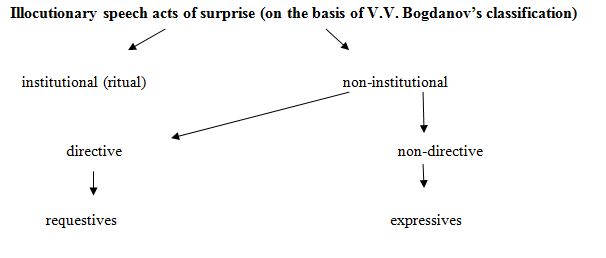Classifications of speech acts expressing surprise.
Surprise is a brief emotional state experienced as the result of an unexpected significant event. The event may be a clap of thunder, the boom of fireworks, or the unexpected appearance of a friend. Everyone is familiar with the feeling of surprise, but it is difficult to describe. One reason for this is the fact that the feeling does not last very long. However, the most important reason is because the mind seems to be blank in the moment of surprise. It is as though ordinary thought processes are momentarily stopped. Thus there is very little though content associated with surprise. In the moment of surprise, a person does not know exactly how to react. There is a feeling of uncertainty created by sudden unexpected event [Izard 1991]. At the same time, it is impossible to determine in which direction the change will go, therefore, surprise is neutral in the beginning. It can retain its neutral character and fade away, if a change of situation does not affect the interests of a person. If surprise affects the interests of a person, than it turns into a negative or positive feeling, that is, becomes a pleasant or unpleasant surprise. Despite the fact that the feeling of surprise is rather short-lived, it performs an important function of clearing the nervous system of ongoing activity that would interfere with adjustment to a sudden change in our environment.
Verbally, surprise presupposes certain stereotypical forms of expressions in Russian and English cultures. Expression of surprise is understood as an implementation of speech act, which is a complex unity of locutionary, illocutionary, perlocutionary acts and social interaction. The communicative intention of the speech act of surprise is to emphasize the unexpectedness of an utterance or event, resulting from the fact that the situation runs counter with what was expected by the addressee.
The analysis showed that the illocutionary purposes of surprise include the following intentions: to express a positive or negative emotional attitude to the new information; to express the speaker’s distrust to the new information so as to get the explanation from the addressee.
The perlocutionary purpose of surprise is to get a positive or negative reaction to a new state of affairs, depending on the situation of communication, so as to demonstrate the interest to the interlocutor and the information produced by him/her. In certain cases, the perlocutionary purpose of surprise is to demonstrate a stereotypical reaction imposed by etiquette. Basing upon Bogdanov’s classification, surprise may be expressed by the following speech acts: institutional speech acts and non-institutional which are subdivided into directive and non-directive speech acts as represented by requestives and expressives respectively. Schematically, it can be presented in the following way:

Institutional speech acts of surprise express a stereotypical reaction imposed by etiquette rules. The purpose of speech acts of surprise is purely phatic: to keep up the conversation, to meet the expectations of the interlocutor, to show attention to the interlocutor and to support him/her emotionally. Non-institutional speech acts imply additional illocutions of directive or expressive character, which are more expressed as compared to standard etiquette reactions of surprise. Directives are speech acts that are to cause the hearer to take a particular action. Thus, non-directives do not urge on the speaker to take action. Expressives, being a sub-class of non-directive speech acts, express the speaker’s feelings and attitudes about some state of affairs specified by the propositional content.
The process of actual verbal communication and the peculiarities of expressing these speech acts in specific situations of communication can modify the intentional content, and create the ground for new meaning and intentions of this speech act. These variants usually have their own designation and include synonymic units of different levels, which are connected with each other by common intentional meaning and general illocutionary force and form the so-called intentional-semantic group.
